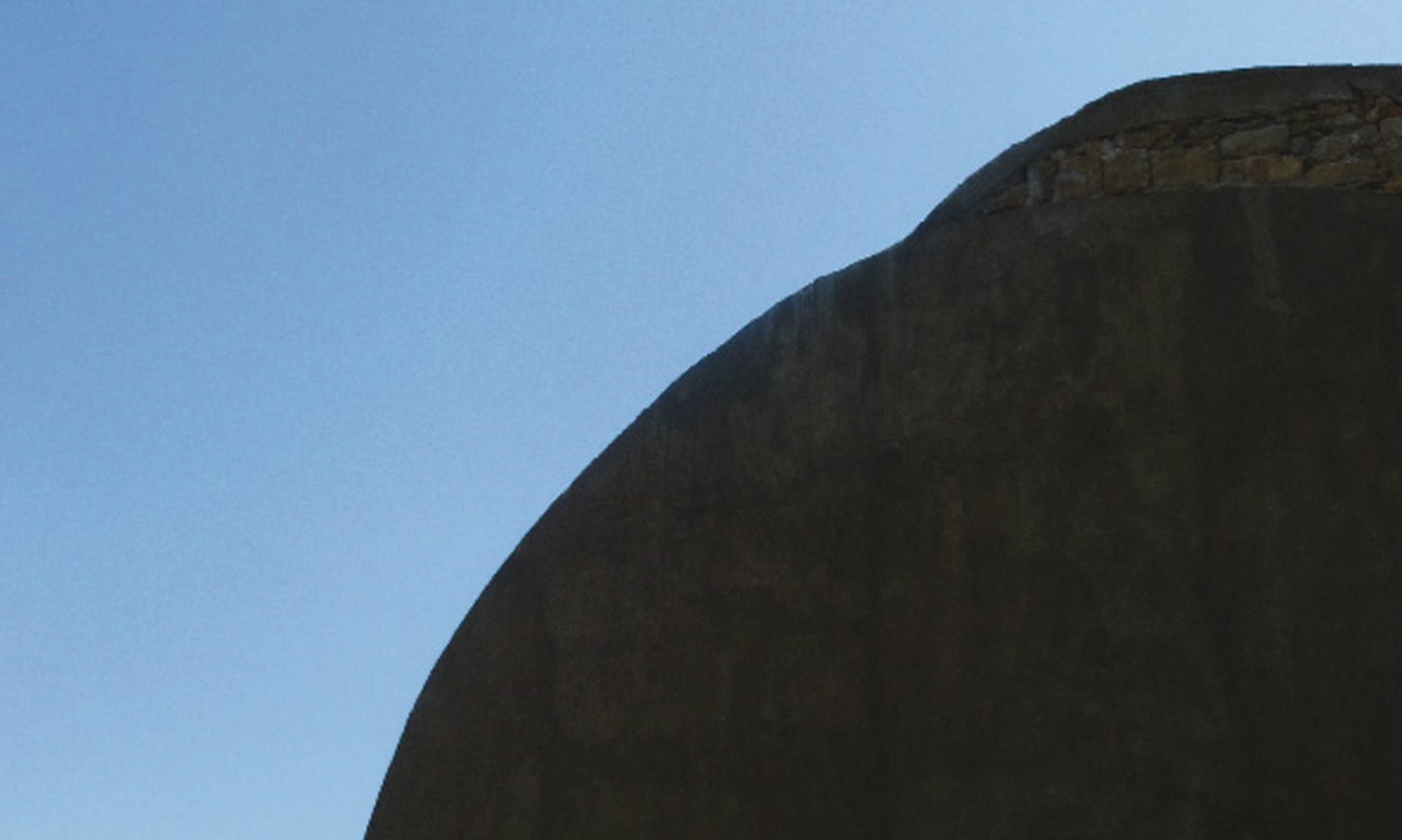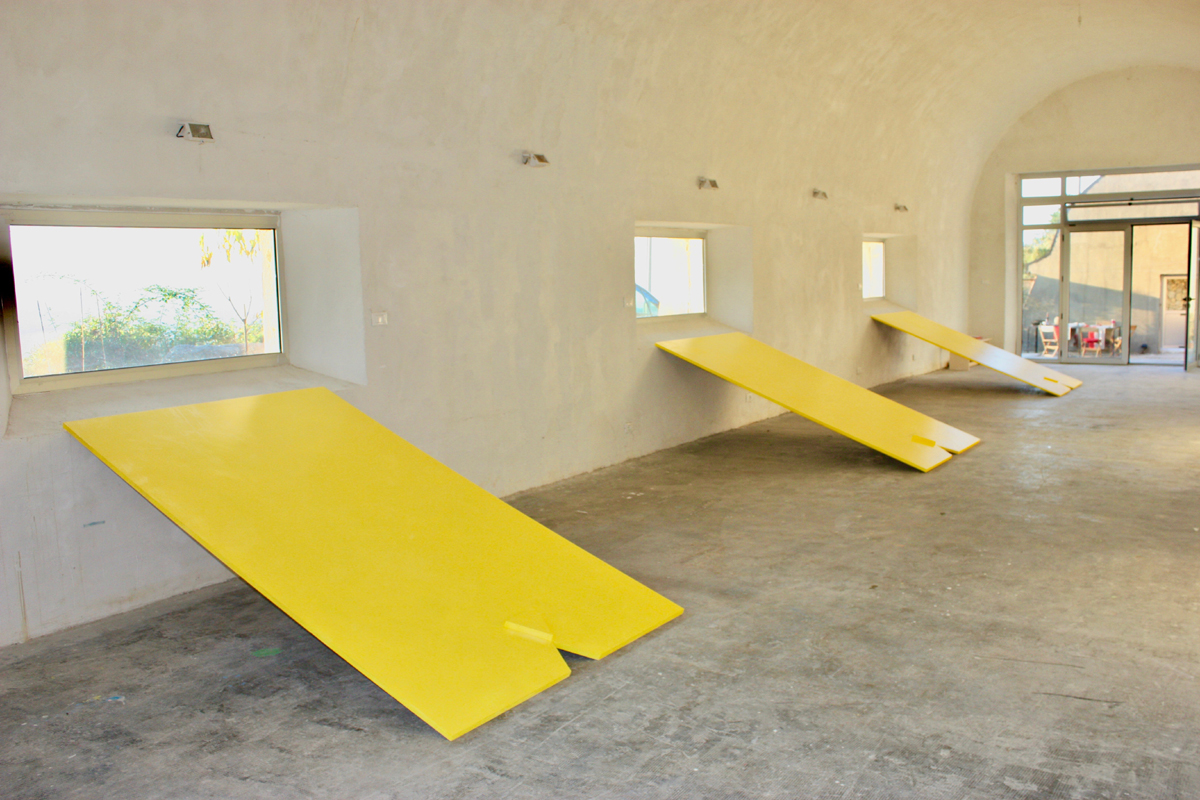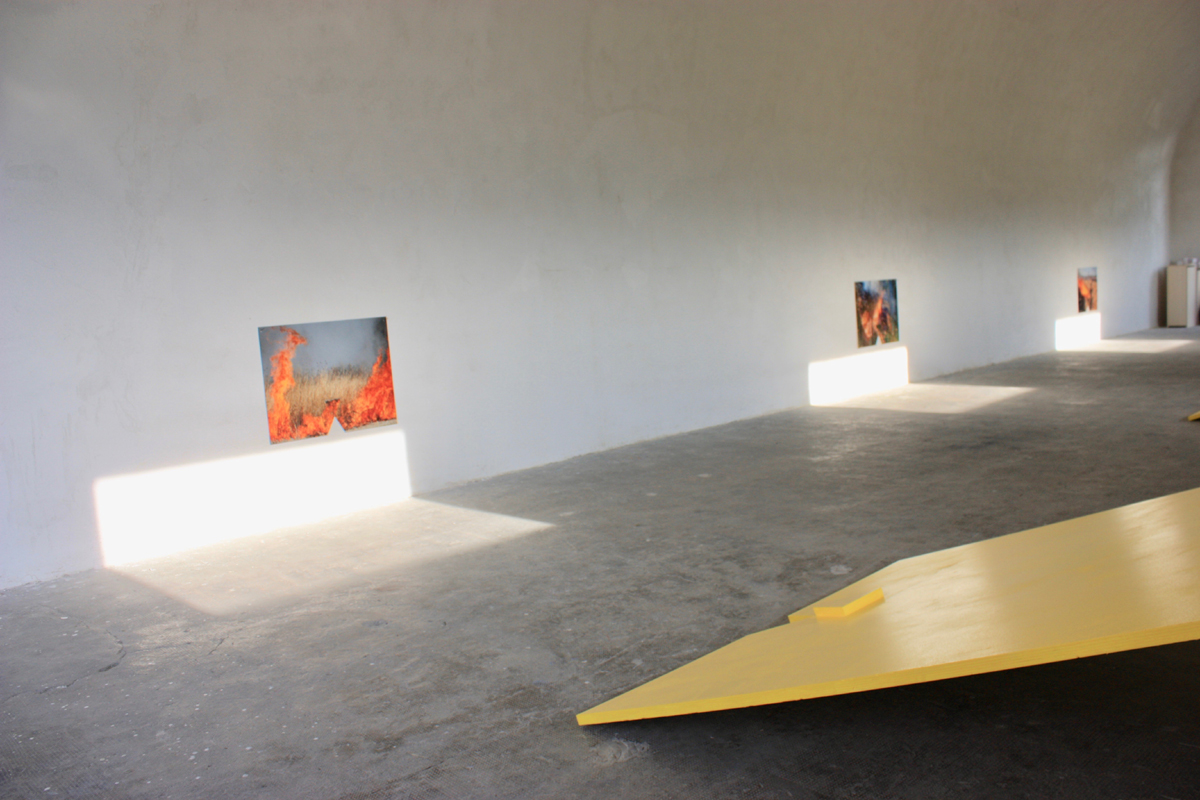THREE SUNSLIDES THREE BRUSHFIRES
22/07/2017 ‐ 06/08/2017
Lucio Pozzi was born in 1935 in Milan, Italy. After living a few years in Rome, where he studied architecture, he came to the United States in 1962, as a guest of the Harvard International Summer Seminar. He then settled in New York and took the US citizenship. He now shares his time between his Hudson (NY) and Valeggio s/M (VR) studios.
In 1978 the Museum of Modern Art, New York, exhibited his early videotapes in one of the first single-artist exhibitions of the Projects:Video series. He occasionally writes and has taught at the Cooper Union, Yale Graduate Sculpture Program, Princeton University, Maryland Institute of Art, School of Visual Arts. He currently is an occasional instructor at art schools in the US and Europe. His work has been presented at Documenta 6 (1977) and at the Venice Biennale (American Pavilion) in 1980. His art is represented in many private and public collections.
“I have turned upside down the canons of my generation’s Conceptual and Analytic art so as to make of them a point of departure instead of a point of arrival. Since then I live my art at the widest range, in all its possibilities. I have chosen to seek the intensity of inspiration by structuring a practice of continuous shifts from one mode of art making to the next. I believe that coherence of style and meaning does not depend on formula but surfaces uncalculated in the practice of the artist.”
Pozzi is a secretly subversive artist. The first scandal came in 1978 in the temple of Conceptualism, the John Weber Gallery in New York, when he exhibited landscape watercolours a few months after having presented in that same space a giant installation of a constructed wall and a photograph, both retouched by relocating small fragments of them. When he then assembled the first Provocation Show, in 1980, again at Weber’s, the critical response was so embarrassing that hardly anyone dared to comment. Many thought Weber and Pozzi had gone mad. The show consisted of 80 works all related to painting but radically different from one another in form and materials. That show was followed by large exhibitions of the same kind in public museums and private galleries: at University of Massachusetts, in Bielefeld and Karlsruhe, at Studio Carlo Grossetti, Milano, and in 1984 a three-gallery show in New York (Leo Castelli, John Weber, Susan Caldwell). Still now, Provocation Shows of Pozzi are occasionally set up by some museums and galleries, while exhibitions of only single families of work also continue.
It seems that since those years many diversified artists’ practices have been accepted in the art world, but Pozzi’s persistence in painting both abstract and representational works, constructing photographic entities and concurrently producing performances and building installations and making videotapes appears to be receiving interest only among the very youngest generations.
His teaching is another way for him to question and probe the fabric of modern art making, in a subtle, individual, case by case dialogue, a capillary manner of guerrilla infiltration instead of shouting sensational slogans.
This year, 2017, besides the installation at DAC in Dolceacqua, Pozzi is exhibiting, in Italy, in June a multiplex selection of works at Rizzuto Gallery in Palermo, a mini retrospective of Oil Removals on paper at Studio La Città in Verona; in September a collaborative performance for Rizzuto Gallery at his exhibition’s finissage, and in October an installation and small paintings at Spazio (in)Visibile in Cagliari. In the US, Pozzi is presenting in October recent paintings at BCB Art in Hudson NY and in November a brief selection of Relocations 1976 – 2017, at Hal Bromm Gallery in New York.
Lucio Pozzi è natonel 1935 a Milano. Dopo aver vissuto alcuni anni a Roma, dove studiava architettura, andò negli Stati Uniti nel 1962 come ospite del Seminario Internazionale di Harvard. Poi si trasferì a New York prendendo la cittadinanza americana. Ora divide il suo tempo fra Hudson, cittadina a nord di New York, e Valeggio sul Mincio, borgo situato fra Mantova e Verona.
Nel 1978 Il Museum of Modern Art gli dedicò una delle prime mostre personali della serie Projects Video. Ogni tanto gli piace scrivere. Ha insegnato alla Cooper Union, al master di scultura della Yale University, alla Princeton University, al Maryland Institute of Art, all’accademia di Brera. Ha fatto parte della facoltà della School of Visual Arts di New York per trent’anni. Ora insegna saltuariamente in scuole d’arte negli SU e in Europa. Il suo lavoro è stato presentato a Documenta 6 (1977) e nel padiglione Americano della Biennale di Venezia (1980). E rappresentato in innumerevoli collezioni private e pubbliche.
“Ho rovesciato I canoni dell’arte Concettuale e Analitica della mia generazione per farne un punto di partenza invece che un punto di arrivo. Da allora vivo la mia arte nell’arco più ampio delle sue possibilità. Ho deciso di cercare l’intensità dell’ispirazione costruendomi una pratica che mi permetta di spostarmi continuamente da un modo di fare arte al prossimo. Sono convinto che la coerenza di stile e significato non dipenda da formule ma emerga senza calcoli preliminari nel fare dell’artista.”
Pozzi è un artista segretamente sovversivo. Il primo scandalo avvenne nel 1978 nel tempio del Concettualismo, la galleria di John Weber a New York, quando espose paesaggi in acquerello pochi mesi dopo aver presentato nello stesso spazio una immensa installazione di un muro dipinto e una foto ritoccati dalle rimozione e collocazione di piccoli frammenti. Quando poi, nella prima delle Mostre Provocazione, nel 1980, riunì 80 lavori tutti riferiti alla pittura ma uno radicalmente diverso dall’altro in forma e materiale, molti pensarono che Weber e Pozzi fossero diventati matti. Nell’imbarazzo generale, quasi nessuno seppe cosa scriverne. Seguirono esposizioni dello stesso genere nei musei dell’Università del Massachusetts, di Bielefeld e Karlsruhe, allo Studio Carlo Grossetti di Milano e nel 1984 nella mostra in tre gallerie di New York (Leo Castelli, John Weber, Susan Caldwell). Ancor oggi, si trovano musei e gallerie che organizzano Mostre Provocazione di Pozzi, mentre continuano anche le esposizioni di singole famiglie di lavori.
Sembra che da quegli anni sono ormai molti gli artisti diversificatori le cui pratiche sono accettate dal mondo dell’arte, ma l’insistenza di Pozzi a dipingere sia quadri figurativi che astratti, costruire entità fotografiche e nel contempo produrre azioni e fabbricare installazioni e produrre video pare ricevere interesse soltanto fra le giovanissime generazioni.
L’insegnamento è per Pozzi un’ulteriore maniera per contestare i dati comunemente accettati e sondare la pratica artistica nel tessuto dell’arte moderna. Invece di gridare slogan sensazionali, egli pratica una sottile, capillare, individuale, caso per caso, infiltrazione guerrigliera.
Quest’anno, 2017, oltre l’installazione al DAC di Dolceacqua, Pozzi espone anche in Italia in giugno una selezione multipla di opere alla Rizzuto Gallery di Palermo, una miniretrospettiva di Oil Removals su carta allo Studio La Città di Verona; a settembre un’azione collaborativa alla RizzutoGallery in occasione del finissage della sua mostra e in ottobre una installazione e piccoli dipinti allo Spazio (in)Visibile di Cagliari. Negli Stati Uniti, a ottobre mostra opere recenti alla BCB Art di Hudson NY e in novembre una piccola selezione di Relocations 1976 – 2017 alla Hal Bromm Gallery di New York.
Lucio Pozzi est né en 1935 à Milan, en Italie. Après avoir vécu quelques années à Rome, où il a étudié l’architecture, il est allé aux Etats-Unis en 1962, invité par le Séminaire d’Eté International de Harvard. Il s’est ensuite installé à New-York et a pris la nationalité américaine. Il partage maintenant son temps entre ses ateliers de Hudson (NY) et Valeggio s/M (VR).
En 1978 le Museum of Modern Art de New York, a exposé ses premières vidéos dans une des premières exposition d’artistes en solo de la série Projects: Video. Il écrit occasionnellement et a enseigné à la Cooper Union, pour le Programme de Sculpture de Deuxième et Troisième Cycles de Yale, à l’Université de Princeton, le Maryland Institute of Art, la School of Visual Arts. Il est actuellement parfois chargé de cours dans des écoles d’art aux Etats-Unis et en Europe. Son travail a été présenté à Documenta 6 (1977) et à la Biennale de Venise (Pavillon américain) en 1980. Ses œuvres sont présentes dans de nombreuses collections privées et publiques.
“J’ai retourné les canons de l’art analytique et conceptuel de ma génération pour en faire un point de départ au lieu d’un point d’arrivée. Depuis lors je vis mon art dans le champ le plus large, dans toutes ses possibilités. J’ai choisi de rechercher l’intensité de l’inspiration en structurant une pratique de déplacements continus d’un type de fabrication d’art vers le suivant. Je pense que la cohérence de style et de signification ne dépendent pas de la formule mais des surfaces non-calculées dans la pratique de l’artiste.”
Pozzi est un artiste secrètement subversif. La premiere scandale a eu lieu en 1978 dans le temple du Conceptualisme, la Galerie John Weber à New York, quand il a présenté des paysages en aquarelle quelques mois après avoir présenté dans le même espace une installation géante d’un mur construit et une photographie, tous deux retouchés en déplaçant de petits fragments de ceux-ci. Quand il a ensuite réuni le premier Provocation Show, en 1980, encore une fois chez Weber, la réponse critique était si gênée que presque personne n’a osé faire de commentaire. Beaucoup ont pensé que Weber et Pozzi étaient devenus fous. L’exposition était composée de 80 œuvres toutes en rapport avec la peinture mais radicalement différentes les unes des autres en forme et matériaux. Cette exposition a été suivie de grandes expositions du même style dans des musées publics et galeries privés : à l’Université du Massachusetts, à Bielefeld et Karlsruhe, au Studio Carlo Grossetti, à Milan, et en 1984 une exposition à trois galeries à New-York (Leo Castelli, John Weber, Susan Caldwell). Encore maintenant, les Provocation Shows de Pozzi sont parfois organisés par des musées et des galeries, tandis que des expositions d’une seule sorte d’œuvres continuent également.
Il semblerait que depuis ces années de nombreuses pratiques diversifiées d’artistes aient été acceptées par le monde de l’art, mais la persistance de Pozzi à peindre à la fois de l’abstrait et des œuvres figuratives, à construire des entités photographiques et produire simultanément des performances, construire des installations et faire des vidéos semble recevoir de l’intérêt uniquement de la part des jeunes générations.
Son enseignement est une autre façon pour lui de remettre en question et fouiller la toile de la fabrication de l’art moderne, dans un dialogue subtil, individuel et au cas par cas, une guérilla d’infiltration par capillarité au lieu de hurler des slogans sensationnels.
En cette année 2017, hormis l’installation à la DAC à Dolceacqua, Pozzi expose en Italie, en juin une sélection multiplexe de travaux à la Rizzuto Gallery à Palerme, une mini rétrospective de Oil Removals sur papier au Studio La Città à Vérone; en septembre, une performance collaborative pour la Rizzuto Gallery pour le décrochage de son exposition, et en octobre une installation et de petites peintures à Spazio (in)Visibile à Cagliari. Aux Etats-Unis, Pozzi présente en octobre ainsi que des peintures récentes à BCB Art à Hudson NY, enfin, en novembre une sélection de Déplacements : Relocations 1976 – 2017, à la Hal Bromm Gallery à New York.



